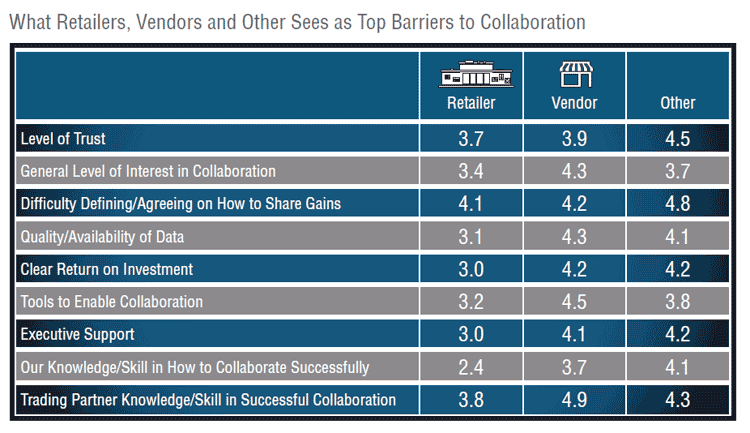We've been talking about better collaboration in the consumer goods value chain for a long while, at least as as far back as the Efficient Consumer Response movement in the 1980s, if not even earlier.
Are things any better here in 2016? Definitely Yes - but not as good as they might be, that's for sure, with lots of Bullwhip Effect and more still going around.
In our benchmark report on the State of Retailer-Vendor Relationships late last year, we asked retailers, consumer goods manufacturers and others (consultants, analysts, academics, etc.) to rate a series of barriers to better supply chain collaboration in the sector.
We recently included the graphic illustrating those results in the March issue of our new Retailer Vendor Performance Management Bulletin, so we thought it made sense to repeat that here as our Supply Chain Graphic of the Week.

As can be seen in the charT, there are definitely some differences of opinion across the three groups.
We will first note that neither retailers nor vendors think their own collaborative capabilities are a big
issue, with average scores of 2.4 and 3.7 from retailers and vendors respectively. Compare that to the much higher barrier scores of 3.8 and 4.9 when retailers and manufacturers rated the other side as a barrier.
"It's not us, it's the other guy,” the message seems to be.
In fact, the lack of trading partner skills in collaboration was the top ranked barrier among vendors, while
the top ranked retail barrier concerned challenges in how to share the gains from any collaboration.
That
was also the top ranked barrier from the opinions of the Other group of respondents.
In general, retailers rated almost every barrier a full percentage point or more lower than vendors, for
reasons that aren’t clear, other than perhaps a somewhat more simplistic view of what collaboration means
versus the vendor perspective.
Your Comments/Feedback
|